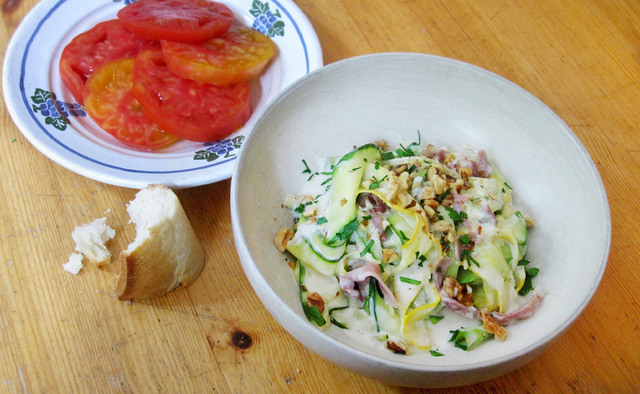Summer squash reproduces so energetically that calling it prolific is understating the case. Still, why not take advantage of its bounty? Here I slice the squash into long ribbons and employ it as “pasta.” Use a mandoline (be sure to
Summer squash reproduces so energetically that calling it prolific is understating the case. Still, why not take advantage of its bounty? Here I slice the squash into long ribbons and employ it as “pasta.” Use a mandoline (be sure to use the guard that comes with it), although a Y-shaped peeler will also work. The resulting “pasta” is more flavorful and less caloric than pasta itself.
I coat the sliced squash with a creamy sauce based on low-fat cream cheese, sometimes called Neufchatel, which is lower in fat and calories than full-fat cream cheese and also lighter in texture. And it’s one of the few dairy products that can be heated in a sauce without curdling in the process.
Summer squash is so tender and delicate that it’s easily overcooked and turned into mush. The goal is to cook it so that it retains a bit of bite, just like pasta al dente. Accordingly, cook it briefly, stirring gently with tongs. Actually, you don’t even stir it; just lift it up and move it around. If you sliced the squash with a mandoline, the “pasta” will likely be thicker than if you used a peeler and will probably require three full minutes to cook. If you used a peeler, you may need no more than two minutes. Again, you want it to turn out tender with a hint of firmness.
Summer squash gives off a lot of water as it cooks, which tends to dilute the sauce. That’s why I advise you to remove the cooked squash from the skillet (to keep it from overcooking) and then reduce the sauce. Boiling off the extra water in this way helps concentrate the sauce’s flavor and make it creamy. Once you’ve reduced the sauce, add back the squash.
For a vegetarian dish, omit the prosciutto and use vegetable broth instead of chicken broth. Serve with a tossed green salad or some dressed sliced tomatoes, and a slice or two of crusty bread.
SUMMER SQUASH RIBBON “PASTA” WITH LEMON CREAM SAUCE
Start to finish: 40 minutes (30 active)
Servings: 4
2 pounds medium summer squash (zucchini, yellow squash or a mix)
1 cup chicken or vegetable broth
1 teaspoon lemon zest
6 ounces Neufchatel (1/3-less-fat cream cheese)
Salt and black pepper
2 ounces thinly sliced prosciutto cut into strips, optional
1 to 2 teaspoons fresh lemon juice, or to taste
1/3 cup toasted chopped walnuts, almonds or pistachios
Freshly grated Parmigiano-Reggiano for garnish
1/3 cup finely chopped parsley
Cut off the ends of the squash and, using a mandoline or a Y-shaped peeler, slice or shave the squash about 1/8-inch thick into wide ribbon-like strips.
In a large skillet, combine the chicken broth and the zest; whisk the mixture until the zest is evenly distributed. Bring the mixture to a boil, break the cheese into small pieces and add it to the skillet. Reduce the heat to a simmer, cover the pan and let simmer for 3 minutes. Remove the lid and whisk the mixture until smooth.
Add the squash ribbons, a pinch of salt and several grinds of pepper and, using tongs, very gently lift up and turn the ribbons in the sauce so they are evenly distributed. Cover and cook for 3 minutes, stirring the squash once or twice with the tongs. Remove the pan from the heat, using the tongs transfer the ribbons from the skillet to a large bowl making sure all the liquid clinging to the squash drips back into the pan. Return the skillet to the heat and simmer the liquid, whisking every so often until it is thickened, about 5 minutes. Return the squash to the skillet, along with the prosciutto and lemon juice; cook for 1 minute, stirring with the tongs. Divide the squash and sauce among 4 pasta bowls; top each portion with some of the nuts, the cheese and the parsley.
Nutrition information per serving: 225 calories; 139 calories from fat; 15 g fat (6 g saturated; 0 g trans fats); 43 mg cholesterol; 547 mg sodium; 12 g carbohydrates; 4 g fiber; 7 g sugar; 13 g protein.



